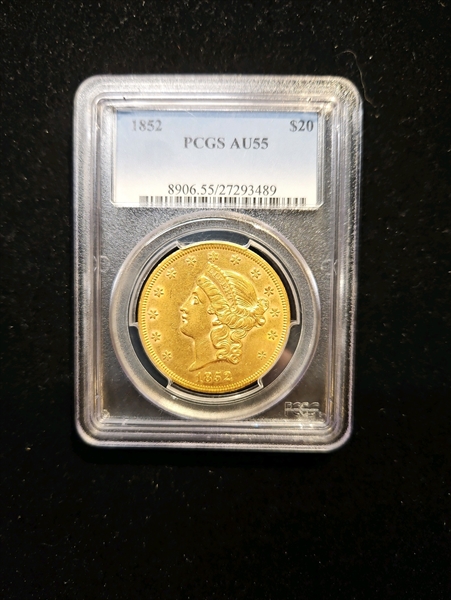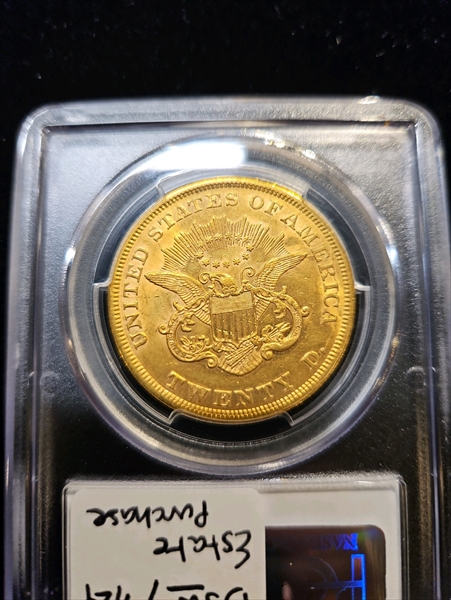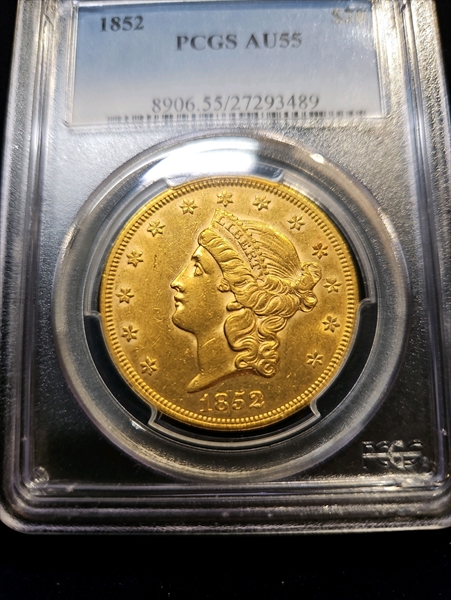1852 $20 AU55 认证号27293489, PCGS号8906
专家评论
Doug Winter
The following information is from my eBook on Type One Liberty Head Double Eagles at http://doubleeaglebook.com/The 1852 is among the more common Type One double eagles. It can be found in nearly any grade through About Uncirculated-55 with little effort, and even nice About Uncirculated-58 examples are only moderately scarce. There are more 1852 double eagles known in Uncirculated than any other non-shipwreck date produced during the 1850’s.
STRIKE: The 1852 is among the better produced Type One double eagles from any mint. The obverse is usually well detailed with sharp, individually defined hair, strong stars and completely separated denticles. The reverse is also well struck. There are some 1852 double eagles which appear to be late die state coins and these are not well defined with weakness at the obverse border. Such coins are usually avoided by knowledgeable collectors.
SURFACES: Many 1852 double eagles show deep, detracting abrasions. It is still possible to find an example which is reasonably clean and the collector should be patient when buying this date, as very clean coins are offered from time to time. Some 1852 double eagles have a network of fine die cracks on the obverse. A few are seen with mint-made copper spotting.
LUSTER: There are at least three kinds of luster seen on this issue. The first—and probably the most aesthetically appealing—is frosty with a slightly granular texture. The second is satiny with a hard brilliance. The third and final is semi-prooflike to almost fully prooflike, with reflectiveness noted in the fields.
COLORATION: The natural coloration ranges from light orange-gold to deep green-gold. It was once very easy to find 1852 double eagles with pleasing natural color. It still isn’t hard, but it is becoming more difficult as many have been dipped or processed.
EYE APPEAL: This issue has above average eye appeal. Most 1852 double eagles are well struck, and higher grade pieces tend to show very good luster. Excessive bagmarks can be a problem but with some patience, the collector should be able to find a pleasing, clean coin.
INTERESTING VARIETIES: The majority of 1852 double eagles have a normal date. A small number (probably not more than 5-10%) have an obvious doubled date which is the result of one date punch being placed slightly low and then corrected with a higher punch. This doubling is most visible on the 52 in the date. It is now formally recognized by NGC and PCGS, and it has become popular as a result. It should bring little premium in lower grades and a premium of maybe 10-15% in AU50 to AU55. It is quite rare in Uncirculated and I haven’t seen more than five or six. The finest known is a PCGS MS63 that was offered as Stack’s Bowers 2014 ANA: 12003 (where it was bought back by the consignor). I sold a PCGS MS62 to a New England collector in August 2014.
PROOFS: No Proofs were struck this year.
HOARDS: 88 pieces were found on the S.S. Republic, including three in MS62.29 examples were recovered from the S.S. Central America. There were 42 in the Baltimore Hoard, including some high grade examples.
BUYING TIPS: This is one of the easiest dates of this type to locate. Collectors should exercise patience as it is likely that without a considerable amount of effort, they will be able to find the “right” coin for their set.
AUCTION RECORD: The current record for this date is $82,250 set by Heritage 2012 ANA: 5408. This coin was graded MS64 by PCGS.
FINEST KNOWN: There are three or four known which grade MS64, and I think these can be ranked in order. The best 1852 double eagle I have seen is the Crawford coin which is in a PCGS MS64 and which has superb color and surfaces. The next best is the Heritage 2012 ANA: 5408 coin ($82,250) which is ex Bowers and Merena 9/08: 822 ($35,650). It is also in a PCGS MS64 and has been approved by CAC. The third best is an NGC MS64 with CAC approval which was sold as Lot 5241 in Heritage’s 2011 sale and it was from the Henry Miller collection. It realized $60,375. NGC has a population of one coin in MS65 and it is likely coin #3 on this list after an upgrade.
FINEST KNOWN, REPUNCHED DATE: The finest known example of this variety is a PCGS MS63 which was in the Gilded Age collection; it was aggressively reserved and it did not sell at the auction. I sold a PCGS MS62 to a New England collector in September 2014 which is the second finest I have seen.
RARITY:
TOTAL KNOWN: 3000-4000+
BY GRADE:
Very Fine: 1125-1350
Extremely Fine: 1250-1550
About Uncirculated: 750-1000
Uncirculated: 75-100
POPULATION FIGURES: As of the beginning of 2015, PCGS had graded five in MS60, 34 in MS61, 36 in MS62, 10 in MS63, and four in MS64 for a total of 89 in Uncirculated. NGC had graded 20 in MS60, 54 in MS61, 29 in MS62, seven in MS63, one in MS64, and one in MS65 for a total of 102 in Uncirculated. NGC had also graded 15 examples in Uncirculated from the S.S. Republic. CAC has approved 13 coins in MS61, four in MS62, and two in MS64.
PERFORMANCE SINCE 2002: A Choice About Uncirculated example (equivalent to an About Uncirculated-55) sells for around $3,500-4,000 in 2014. In 2002, this coin would have sold for $800-1,000. An average quality Uncirculated example (equivalent to a Mint State-61) sells for around $11,000-13,000 in 2014. In 2002, this coin would have sold for $3,000-4,000, and would likely have been choicer for the grade than today’s MS61.
COMMENTS: A few exceptional 1852 double eagles have been graded by PCGS and NGC since the first edition of my Type One double eagle book was released in 2002. This includes the first and only MS65 and a small number of MS64’s. Until recently, none of these ultra-high grade 1852’s had sold at auction but three examples graded MS64 have been auctioned since 2008. These MS64’s are among the very few non-shipwreck Type One double eagles that are available in such a high grade, and such coins are very popular with type collectors seeking a very choice single example for their sets. I remain intrigued by the 1852 Double Date and think it is undervalued in AU55 and higher.
David Akers (1975/88)
The 1852 is a "common date" by Type I Double Eagle standards. (Of course, the term "common date" is a very relative one and "common" by Type I standards is clearly not the same thing as "common" by Type III standards). Overall, the 1852 is similar in rarity to the 1850, 1851 and 1853 although it is definitely more often obtainable in Unc. than either the 1850 or the 1853. Uncs are very scarce and gem quality specimens are rare. Most 1852 Double Eagles are frosty and fully prooflike pieces are very rare. Very few cataloguers mention the fact, but the 1852 comes with both a thin date and a thick date. On the thin date, the vertical bar of the 5 does not reach the ball ("open" 5) while on the thick date, the vertical bar goes down beyond the top of the ball ("closed" 5). There is little difference in the rarity of these two major varieties and thus no premium is attached to one over the other.PCGS #
8906
设计师
James Barton Longacre
边缘
Reeded
直径
34.00 毫米
重量
33.40 克
铸币数量
2053026
金属成分
90% Gold, 10% Copper
更高评级数量
346
评级较低的钱币数量
811
地区
The United States of America
价格指南
PCGS 数量报告
拍卖 - PCGS 评级的
拍卖 - NGC 评级的
稀有性和存量估计 了解更多
| 所有评级 | 4782 |
| 60或以上 | 81 |
| 65或以上 | 0 |
| 所有评级 | R-4.0 |
| 60或以上 | R-8.1 |
| 65或以上 | R-10.1 |
| 所有评级 | 41 / 44 |
| 60或以上 | 34 / 44 |
| 65或以上 | 1 / 44 |
| 所有评级 | 90 / 148 TIE |
| 60或以上 | 64 / 148 TIE |
| 65或以上 | 1 / 148 |























